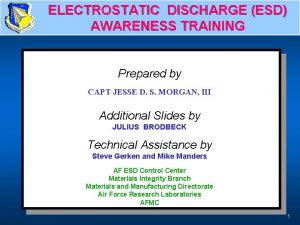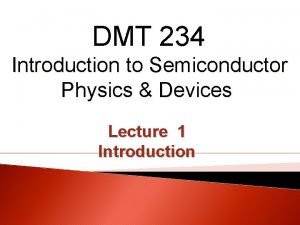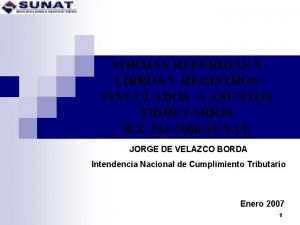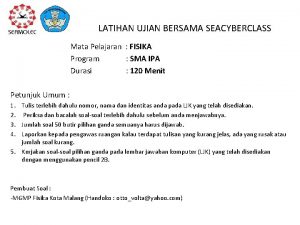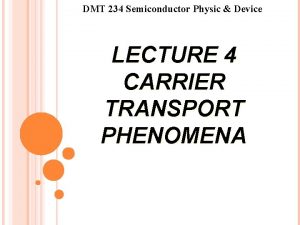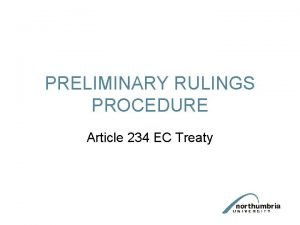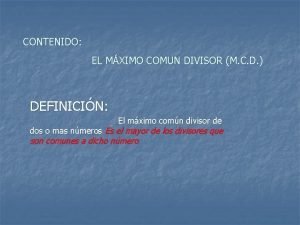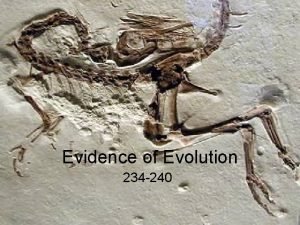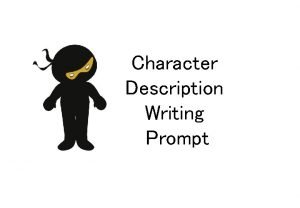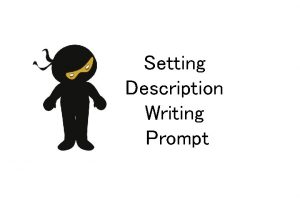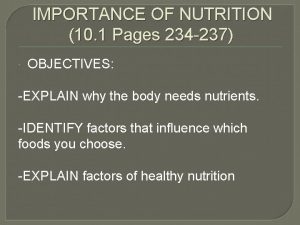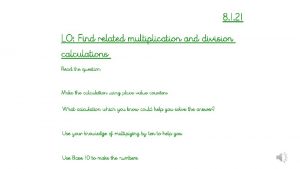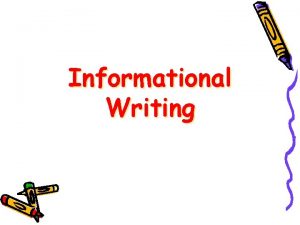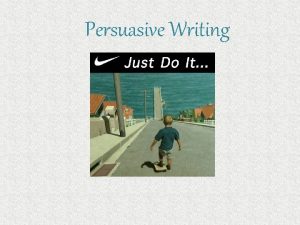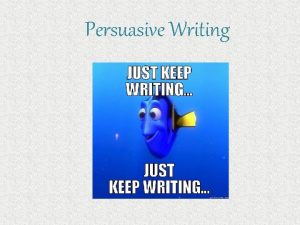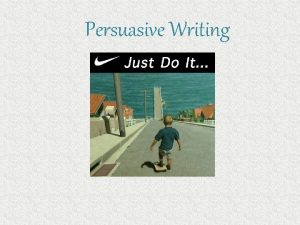WRITING A DESCRIPTION PAGES 234 240 June 15


















- Slides: 18

WRITING A DESCRIPTION PAGES 234 -240 June 15, 2011

What is Description? Description presents information in a way that appeals to one or more of the five senses – sight, sound, smell, taste and touch – usually creating an overall impression or feeling. “Biting into a tabasco pepper is like aiming a flamethrower at your parted lip”

Characteristics of Descriptive Writing: Sensory Details Active Verbs Dominant Impression Effective Connotative Language Comparisons Organization

Characteristics of Descriptive Writing: Sensory Details Sight: Create a “specific” mental picture for your reader Sound: Onomatopoeia – use active verb words that sound like what they describe: hiss, whine, sizzle Smell: Use nouns that evoke distinct odors, but leave it up to the reader to imagine the smell. Taste: Flavor adjectives Touch: Texture, temperature, weight.

Characteristics of Descriptive Writing: Active Verbs Use Active Verbs instead of Adverbs to create a more lasting impression: Original: The team captain proudly accepted the award. Revised: The team captain marched to the podium, grasped the trophy and gestured toward the team.

Characteristics of Descriptive Writing: Dominant Impression Overall attitude, mood or feeling about the subject To write an effective description, you need to select details carefully, including only those that contribute to the dominant impression you are trying to create. In “Eating Chilli Peppers” the author is focused on their firery hotness. Does he need to include details about size, shape, texture?

Characteristics of Descriptive Writing: Effective Connotative Language Denotation – the dictionary definition of a word Connotation – the feelings and attitudes associated with a word Be careful of the connotations of words you choose. Make sure they strengthen the dominant impression you want to make: fake/atificial firm/stubborn

Characteristics of Descriptive Writing: Comparisons When describing a person or an object, you can help your reader by comparing it to something with which they are familiar. Metaphors, Similes, Personification

Characteristics of Descriptive Writing: Organization Effective description must follow a clear method of organization Spatial Order: terms of physical position of its parts: top to bottom, left to right Chronological – events or changes that occur over time: changes in a child, a flower, a day. Most to least, least to most -

Example Paragraph “Asparagus. ” The word itself made my fingers quiver. It was the length of a sharp number two pencil but instead of lead it had diminutive leaves attached to the tip. It had only one purpose which was to fool the digester into thinking a pretty delicious gift was coming its way. It was as if they curled around the pointed tip, but I was too smart to be fooled. I knew that only misery waited under the dark green lying leaves. It had pale pea-like lines that wrapped around the forest-like stalks, leaving a quarter of an inch separating the filth into four or five sections, of horror. Looking from the outside, it seemed as if it was layered like an onion. It appeared that the first layer was a sea green with a sheer touch of color from the inside of a lime. The pigment grew more menacing the deeper the layers went. The thought of this satanic vegetable going near any part of my body was ultimately a chaotic nightmare.

Concrete vs. Abstract Language Concrete words add life and meaning to your writing. General: Store Less General: Department Store More Specific: Sears at the Galleria Mall “The red flowers were blooming in our yard” “Crimson and white petunias were blooming in the garden on the west side of the garage”

Specific vs. Vague To make your paragraphs concrete and SPECIFIC, use the following guidelines: 1. Focus on who, what, when, where, how and why 2. Name names. People, Places, Brands, Objects 3. Use Action Verbs. 4. Use descriptive language to appeal to the senses (smell, touch, taste, sound, sight) 5. Use adjectives and adverbs carefully.

Verbs Do Your Sentences Have Strong, Active Verbs? “To Be” verbs and other linking verbs (feels, became, seems, appears) which connect a noun or pronoun to words that describe it, can make your writing dull. Whenever possible, use stronger, more active verbs! “To Be” Verb: The puppy WAS afraid of thunder. Action Verb: The puppy WHIMPERED and QUIVERED during the thunderstorm. Linking Verb: The child LOOKED frightened as she boarded the bus for her first day of kindergarten.

Passive/Active Verbs In a sentence containing PASSIVE VERBS (“to be”), the subject does not perform the action of the verb but instead receives the action. By contrast, in a sentence with an ACTIVE VERB, the subject performs the action. Passive: It WAS CLAIMED by the cyclist that the motorist failed to yield the right of way. Active: The cyclist CLAIMED that the motorist failed to yield the right of way.

Verbs “TO BE” Verbs (Passive) am, is, are, was, were, being, been The car WAS REPAIRED by Tom Once a week, the house IS CLEANED by Jane Action Verbs (Active): Express physical or mental activities. The dog RAN down the street Jen THOUGHT the assignment was due.

Passive vs. Past Tense Past Tense: I taught; I learned. Passive Voice: I was (have been) taught [by someone]; It was (has been) learned [by someone]. Present Tense: I teach; I learn. Passive Voice: I am [being] taught [by someone]; It is [being] learned [by someone]. Future Tense: I will teach; I will learn. Passive Voice: I will be taught [by someone]; It will be learned [by someone].

Concrete vs. Abstract Language Revise the following sentences by adding concrete, specific details. Make sure to use active verbs! 1. 2. 3. 4. 5. The book I took on vacation was exciting reading. The vase in the museum was an antique. At the crime scene, the reporter questioned the witnesses. The students watched as the instructor entered the lecture hall. The house was old and needed updating.

Homework for Monday Bring 3 copies of your descriptive paragraphs, typed and in MLA format. You may write about a person or a place. Narrative Frame and “Show, Don’t Tell”
 Printed pages vs web pages
Printed pages vs web pages Is the standard page description language for web pages
Is the standard page description language for web pages 00-25-234
00-25-234 Device physics
Device physics Dmt 234
Dmt 234 Dmt 234
Dmt 234 Oblicz objętość tlenu i azotu w swoim pokoju
Oblicz objętość tlenu i azotu w swoim pokoju Rs 234-2006
Rs 234-2006 Preservative ins 234
Preservative ins 234 Sebuah tangki terbuka diisi dengan air sampai setinggi 6 m
Sebuah tangki terbuka diisi dengan air sampai setinggi 6 m Dmt device
Dmt device Article 234 ec
Article 234 ec Máximo común divisor de 126 y 162
Máximo común divisor de 126 y 162 234 235
234 235 Reflex arc animation
Reflex arc animation Nasa evm implementation handbook
Nasa evm implementation handbook Data cleaning
Data cleaning 234 / 18
234 / 18 1234 × 567 - 234 × 567
1234 × 567 - 234 × 567


